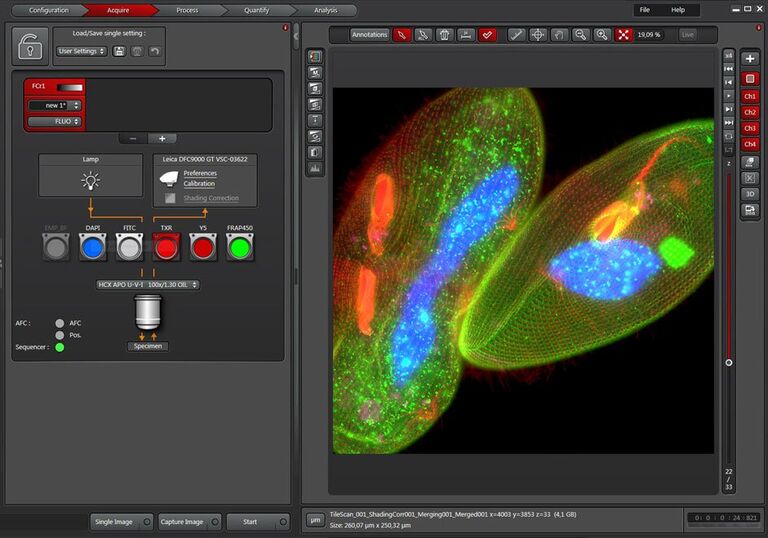DFC9000 sCMOS camera
Get closer to reality
Imagine you could image live cells as close as possible to their native state. Capture even faint fluorescent signal you currently miss. And discover what happens in the time between two subsequent images. Imagine you could get a better view of what really happens in cells!
The Leica DFC9000 sCMOS camera will turn your imagination into reality. This monochrome microscope camera with newest scientific CMOS (sCMOS) sensor technology for fluorescence imaging enables you to image your cells under near-native conditions.
- Protect your cells with short exposure times
- Capture highly dynamic processes with high-speed acquisition
- Get more information in one image with large field of view
This Introduction to Camera Technology helps you judge camera performance.
Every photon counts
The Leica DFC9000 is built with a third-generation sCMOS sensor, currently state-of-the-art on the market. It performs with a quantum efficiency* of up to 82%.
- Capture even the faintest, previously undetected fluorescence signals
- See processes in the cell in the most realistic detail without unhealthy overexpression of the GFP-coupled protein
Reduce exposure times to a minimum
- Protect your cells, reducing stress, and minimizing phototoxicity effects
- Generate more reliable results with happy GFP-expressing cells
Protect your cells with high near-infrared sensitivity
- Use red-emitting fluorescence tags to further reduce cell damage
- Observe your cells with an outstanding spectral response of more than 60% quantum efficiency at 750 nm wavelength
*quantum efficiency depends on wavelength of light
Life in the fast lane
What happens in the time between the acquisition of two subsequent images? Until now, this has been a study in guesswork.
With a capture-rate of 50 frames per second (fps) via its USB 3.0 interface, the Leica DFC9000 GT is in the fast lane – and we’re talking full frames!
- Acquire real-time, high-speed time-lapse recordings with accurate time stamps
- Prove the intermediate steps of the complete temporal sequence of processes you are analyzing
If you want even more speed, you can freely define a region of interest to reduce readout area.
And if faster than fast is still not fast enough, use the Leica DFC9000 GTC variant:
With the Leica DFC9000 GTC, the camera can capture images at a rate of 90 fps full-frame via the Camera Link interface. If you want to reduce data volume and shorten exposure times further, choose from five binning modes to balance out resolution and data volume.
Catcher of the light
The Leica DFC9000 is designed for high-end fluorescence imaging of live cells such as time-lapse experiments.
Less noise means a better image. In technical terms, a high signal-to-noise ratio (SNR) provides you with a crisp fluorescence signal against a dark background.
The Leica DFC9000 is a highly sensitive sCMOS camera:
- High quantum efficiency over the entire light spectrum with a maximum of 82%
- Low read noise of 0.9 e- at 216 MHz pixel clocking rate
- Cooled sensor; cooling to 0° Celsius by air circulation
These features make the Leica DFC9000 also ideally suited for our lightsheet system Leica TCS SP8 DLS.
Matchmaking by Leica
See more with imaging systems from one source: Leica Microsystems provides you with imaging systems specifically designed to take full advantage of sCMOS sensors to ensure that you do not miss any data.
The uniquely perfect match
- 19 mm diagonal of the Leica DFC9000’s sCMOS sensor
- 19 mm camera port with full optical correction in many Leica research microscopes
Acquire fewer images
- If you want to acquire tile scans or mosaics, fewer individual images are required
- Save time and protect your samples
Conduct your imaging orchestra
The Leica DFC9000 is part of a carefully tuned microscope platform capable of being triggered at high speed. Protect cells from unnecessary light, take advantage of fast filter changes for your multicolour imaging.
Leica Application Suite X software
Triggering is based on Leica Microsystems’ flexible electronic box system and Leica Application Suite X (LAS X) software.
- Flexible: Trigger up to 2 cameras with the electronic box
- Simultaneous: Combine the camera with DualView or Gemini for simultaneous acquisition of 2 wavelengths
Workflow facilitator
A broad range of tools from the LAS X software available with the Leica DFC9000 provides you with the versatility to document your live cells and fixed specimens with ease.
- High-speed, real-time time-lapse
- Extended depth of focus
- Deconvolution
- 3D rendering and analysis
Are you not yet familiar with advanced camera features? Some of these features can be hidden in the user interface through a smart user access approach. Different levels of access can be granted to inexperienced users or experts, to make your workflow more efficient.
LAS X can be used with all Leica fluorescence cameras.





